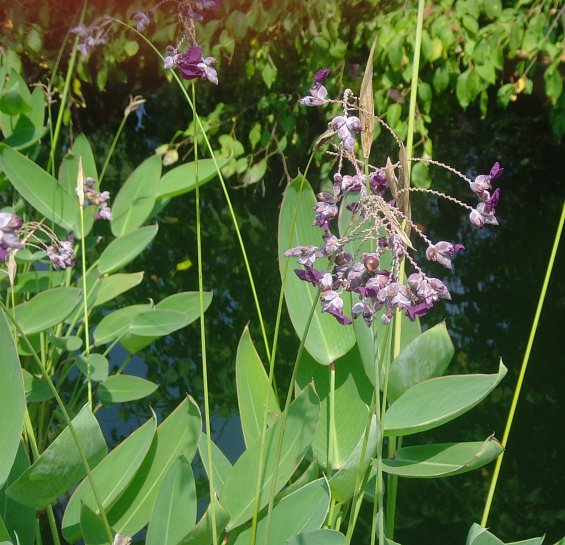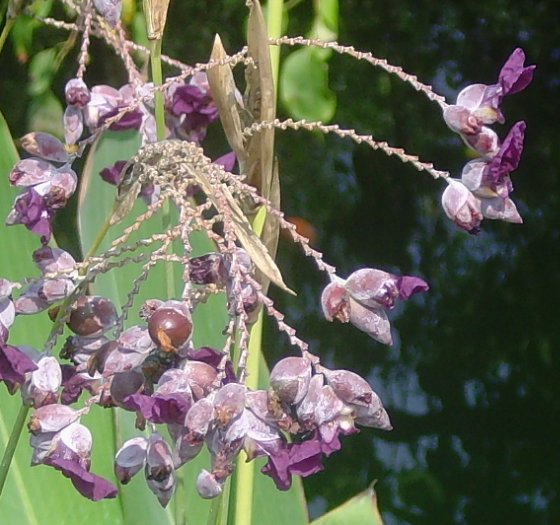
An erect or ascending stalk about 4-8' tall terminates in a floral panicle about 4-18" long with a leafy bract at its base that is early-deciduous. The lateral branches of the panicle are ascending to drooping and slightly zigzag; they are reddish brown, but covered with a white powdery bloom. The whitish purple flowers develop in pairs along these lateral branches, where they bloom in succession. Adjacent pairs of flowers are spaced about 3 mm. from each other. A pair of large floral bracts are located at the base of each pair of flowers; these bracts are powdery white. Each flower is about 10-17 mm. long, consisting of 3 sepals, 3 petals, an ovary with a single style, a single fertile stamen, and 3 staminodia (sterile stamens). The membranous sepals are about 2 mm. long and insignificant. The petals join together at the base, forming a short corolla tube. The fertile stamen and staminodia are highly modified petaloid structures; they are purple to whitish purple and showy. The hooded staminodium has a pair of trigger-like appendages that, when they are depressed, release an elastic style with a cup-shaped stigma, enabling cross-pollination of the flower. The blooming period occurs from mid- to late summer, lasting about 1 month (in Illinois). Afterwards, fertile flowers are
 replaced by globoid-ovoid
seed capsules. Each capsule
contains a single large seed about 8 mm. long that is dark
brown, globoid-ovoid in shape, and smooth. The root system is
rhizomatous, from which
clonal colonies of plants are produced.
replaced by globoid-ovoid
seed capsules. Each capsule
contains a single large seed about 8 mm. long that is dark
brown, globoid-ovoid in shape, and smooth. The root system is
rhizomatous, from which
clonal colonies of plants are produced.Cultivation: The preference is full sun, wet ground with up to 1½' of water, and muddy or clay soil with organic matter. This wildflower can be propagated by either its seeds or division of its rhizomes. It is hardy to Zone 5 or Zone 6 if the rhizomes are protected by standing water during the winter and a northern ecotype is selected.
Range & Habitat: The native Powdery Thalia has been found in Alexander County at the southern tip of Illinois, where it is rare and state-listed as 'endangered.' Elsewhere in the state, it is absent. Illinois lies along the northern range limit of this species; it is more common in areas further south. Habitats include margins of ponds, marshes, swamps, and wet ditches along roads. Powdery Thalia is cultivated occasionally as an ornamental plant for ponds and wetland gardens.
Faunal Associations: The unusual flowers rely on explosive secondary pollination. The anther of the fertile stamen drops pollen grains onto a depression of the elastic style (immediately behind its stigma) during evening hours. The following morning, flower-visiting insects can trigger an appendage of the hooded staminodium, releasing the elastic style with its load of pollen. This area of the style strikes near the insect's head. The flowers of Powdery Thalia are cross-pollinated by nectar-seeking carpenter bees (Xylocopa virginica) and possibly large bumblebees (Bombus spp.); flies and other smaller insects often become trapped by the elastic styles of the flowers and die. Such floral visitors as large butterflies and hummingbirds are able to feed on nectar without triggering the explosive mechanism of pollen delivery; they are considered nectar thieves. The caterpillars of Calpodes ethlius (Brazilian Skipper) feed on the leaves of Powdery Thalia; they are leaf-rollers. This skipper does not successfully overwinter in Illinois, but it migrates northward and can reach the state during the summer. The large seeds are eaten by the Mallard, Lesser Scaup, and probably other ducks (Martin & Uhler, 1939).

Photographic Location: A botanical garden in Chicago, Illinois. The photographs were taken by Rita Ryan (Copyright © 2012).
Comments: Powdery Thalia is the only species in the Arrowroot family that is native to Illinois. It is a tropical-looking plant with large showy leaves and unusual purple flowers. The only other species of this genus that is native to the United States, Thalia geniculata (Alligator Flag), is found primarily in areas along the Gulf coast. It differs from Powdery Thalia by the lack of white powdery bloom on its foliage and flowers. In addition, the lateral floral branches of Alligator Flag are more zigzag than those of Powdery Thalia because adjacent pairs of its flowers are more widely spaced (at least 5 mm. apart).